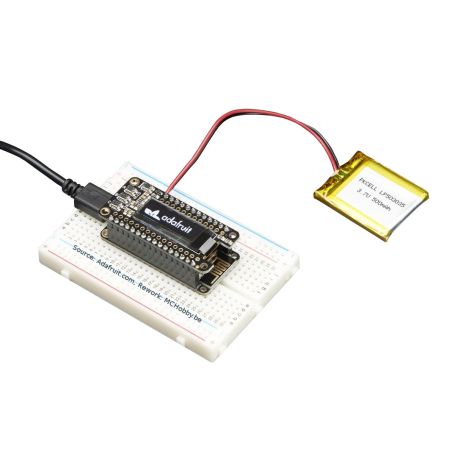[T] - Feather OLED screen
FeatherWing with 128x32 OLED screen, for all Feather boards
Payments are secured by LyraCollect, a French payment collection company.
It is possible to delivered to your home, to a pick-up point or picked up by appointment at MCHobby
We prepare, pack and ship your orders with great respect and care.
128x32 OLED display made for the Feather board
A Feather board without extension is a Feather board without ambition! Here is the FeatherWing OLED: it adds a 128x32 monochrome OLED screen as well as 3 user buttons on any Feather board. By using stacking header for Feather or female Feather connector, you can connect a FeatherWing extension board above (or below) your Feather board!
This display is small with a diagonal of 1 "(2.54cm) but keeps a great readability thanks to the strong contrast of OLED technology. The screen has 128x32 individual OLEDs pixels/points and you will not need backlighting since the pixels of the screen produce their own light. This drastically reduces the consumption of the screen and explains why it has such a good contrast.
It's these crisp features that make us particularly fond of OLED screens! This FeatherWing OLED is also equipped with a reset button and 3 mini touch buttons named A, B and C ... enough to allow you to add a mini-interface to your Feather.
Tested and functional on the Feather 32u4, M0 and ESP8266 boards. The OLED screen only uses two pins since it works on the Feather's I2C bus and it's easy to stack this FeatherWing with other FeatherWing boards (they can even share the same I2C bus).
To use this screen, follow the tutorial which explains how to install and use the Arduino library. This screen is the version of the 128x32 I2C OLED breakout made for the Feather range.
Technical details
- OLED UG-2832HSWEG02 datasheet
- Board/PCB size: 22.9mm x 50.9mm
- Display size: ~25.8mm / ~1.0"
- Weight: 4.8g
- On a Feather 32u4 or M0, the buttons A, B & C are respectively connected to 9, 6, 5
- On a Feather Huzzah ESP8266, the buttons A, B & C are respectively connected to 0, 16, 2.
Tutorials
- FeatherWing OLED (Adafruit, English)
- WiFi OLED badge (Adafruit, English)







